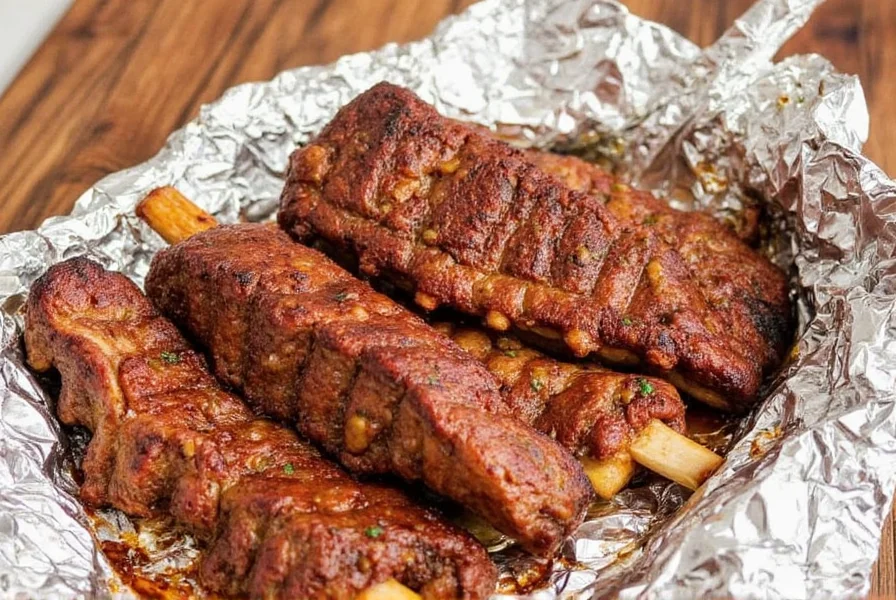Table of Contents
Introduction
Cooking ribs in the oven using aluminum foil is a proven technique for achieving tender, juicy results. This guide provides step-by-step instructions on how to properly wrap and cook ribs with foil, including cooking times, temperature settings, and expert tips to avoid common mistakes.

How to Cook Ribs with Foil
Using aluminum foil correctly is essential for perfect oven-baked ribs. Follow these steps for tender, flavorful results:
- Prepare the ribs: Remove the membrane from the bone side of the ribs and apply your favorite dry rub or marinade.
- Wrap tightly: Place ribs on a large sheet of heavy-duty aluminum foil. Fold the edges securely to create a sealed packet that traps steam.
- Add moisture: Include 2-3 tablespoons of liquid (apple juice, broth, or vinegar) inside the foil packet to create steam and prevent drying.
- Bake at low temperature: Cook at 275°F (135°C) for 2.5-3 hours. The foil creates a controlled steam environment that breaks down connective tissues.
- Finish with high heat: Remove ribs from foil, brush with sauce, and broil for 5-10 minutes for caramelized crust.
Practical Tips for Using Foil with Ribs
Follow these expert tips to maximize your foil-cooking results:
- Seal completely: Ensure no gaps in the foil packet to maintain consistent steam pressure and prevent moisture loss.
- Use heavy-duty foil: Standard foil may tear during handling, while heavy-duty foil (18-20 microns) withstands handling and liquid content better.
- Check internal temperature: Ribs are done when internal temperature reaches 195-203°F (90-95°C) for optimal tenderness.
- Rest before serving: Let ribs rest for 10-15 minutes wrapped in foil after cooking to allow juices to redistribute.
Choosing the Right Aluminum Foil
When selecting aluminum foil for ribs, focus on these key characteristics:
| Foil Type | Thickness | Best For | Why It Matters |
|---|---|---|---|
| Standard Aluminum Foil | 12-16 microns | Lightweight tasks like wrapping sandwiches | Prone to tearing with moist foods or large cuts of meat |
| Heavy-Duty Aluminum Foil | 18-20 microns | Cooking ribs, roasting vegetables, and grilling | Withstands high heat and moisture without tearing |
For ribs specifically, always choose heavy-duty foil. Its extra thickness prevents leaks during cooking and maintains structural integrity when handling large cuts of meat. Most grocery stores carry heavy-duty foil in standard 12-inch or 18-inch widths - select the size that comfortably fits your rib rack with extra space for sealing.
Frequently Asked Questions
How long should I cook ribs in the oven with foil?
For tender, fall-off-the-bone ribs, cook at 275°F (135°C) for 2.5 to 3 hours wrapped in foil. The foil creates a steam environment that speeds up tenderization. A good rule of thumb is 45 minutes per pound of ribs. After this time, remove the foil and finish cooking for an additional 30 minutes to develop that perfect crust.
Should I poke holes in the foil when cooking ribs?
No, you should seal the foil packet completely without holes for the first part of cooking. This traps moisture and creates a steam environment that tenderizes the ribs. The only time you might want to create small vents is during the final finishing stage if you're adding more sauce and want some caramelization without making the sauce too runny.
What's the Texas Crutch method and how does it relate to cooking ribs with foil?
The Texas Crutch is a barbecue technique where meat is wrapped in foil midway through cooking to speed up the process and prevent the stall (when evaporation cools the meat and slows cooking). For ribs, this means wrapping after the initial 1-2 hours of smoking or baking. Adding liquid like apple juice or butter inside the foil packet creates steam that tenderizes the connective tissues faster while locking in flavor.
Can I reuse aluminum foil when cooking ribs?
While technically possible, it's not recommended to reuse foil that has come into contact with raw meat due to potential bacterial contamination. Always use fresh foil for cooking ribs to ensure food safety and optimal performance.
What's the secret to preventing dry ribs when using foil?
The key is adding the right amount of liquid to the foil packet. Add ¼ cup of apple juice, beer, or broth along with 2 tablespoons of butter to create steam without making the ribs soggy. Another pro tip: place sliced onions or apple slices under the ribs in the foil packet—their natural sugars and moisture enhance flavor while keeping ribs juicy. Don't skip the resting period after cooking; let ribs rest for 10-15 minutes wrapped in foil to allow juices to redistribute.
Is there a difference between regular aluminum foil and heavy-duty foil for cooking ribs?
Yes, heavy-duty foil (typically 18-20 microns thick) is recommended for cooking ribs as it's less likely to tear when handling large cuts of meat or when the packet contains liquids. Regular foil (12-16 microns) may develop small tears that allow moisture to escape, resulting in less tender ribs. Heavy-duty foil also withstands higher temperatures and provides better heat distribution for more even cooking.
Conclusion
Using aluminum foil correctly is the key to perfect oven-baked ribs. By following these techniques for wrapping, cooking times, and finishing methods, you'll consistently achieve tender, juicy ribs with minimal effort. Remember to choose heavy-duty foil for best results, seal packets tightly, and always allow proper resting time before serving.










 浙公网安备
33010002000092号
浙公网安备
33010002000092号 浙B2-20120091-4
浙B2-20120091-4